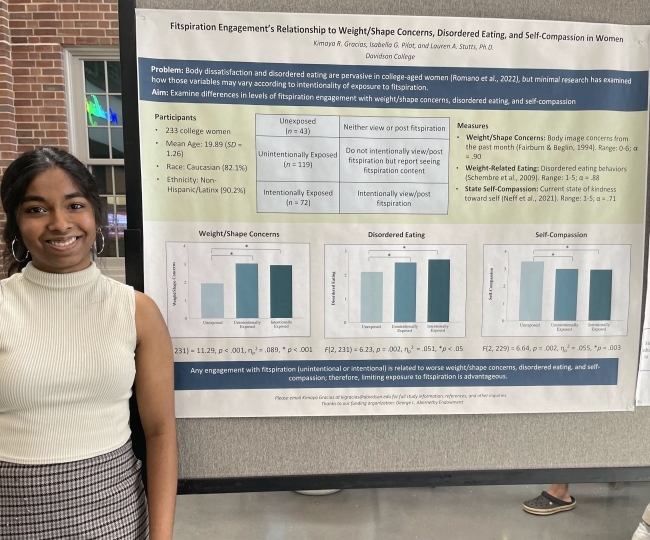‘Fitspiration’ Social Media Posts Affect Body Image. Here’s What to Do About It
June 3, 2024
- Author
- Mark Johnson

A photograph of a thin spandex-clad influencer with perfect hair and chiseled biceps rolls through a young woman’s feed on a social media channel. She was not intending to see it but caught a glimpse.
How bad could that be? “It’s worse than you might think,” said Lauren Stutts ’05, associate professor of public health at Davidson College. “The images of thin, active women are tagged on Instagram as #fitspiration or #fitspo, which stands for fitness inspiration. In my first fitspiration study, we found participants who viewed fitspiration images had decreased body satisfaction and increased negative mood after exposure to the images.”
More than 72 million Instagram posts are tagged as #fitspo, she said: “They’re exposed to it constantly.”
Students already face academic pressure and constant comparisons. The social media anxiety can push them in an unhealthy direction.
Kimaya Gracias, who graduated from Davidson in May, co-authored a recent paper with Stutts.
“Everyone has moments of difficulty with their body image,” she said, “especially in college, when you’re stressed.”
Stutts’ portfolio of research, though, has focused on more than identifying the problem. She has some solutions.

Kimaya Gracias ’24 presented research on the effects of fitness inspiration social media posts on body image among young women at the Verna Miller Case Research and Creative Works Symposium.
It’s in My Feed
Images long have wielded powerful influence, from an apocalyptic presidential campaign ad in 1964 to subliminal frames in The Exorcist to the Madison Avenue axiom: image sells the brand.
Instagram is one of the most popular social media platforms among younger Americans. The Pew Research Center collected data showing 71% of 18-to-29-year-olds in the U.S. reported using it. More than half of those log on several times a day.
Research, including by Stutts, has tied social media image consumption to body image concerns. Her previous research also has shown that more than 60% of women and more than half of men reported weight or shape concerns or disordered eating, or all of those, at the end of their first year of college. Disordered eating involves abnormal eating behaviors but is not a clinical diagnosis, like an eating disorder.
The eye-popping part of the most recent paper published in the journal Eating Behaviors by Stutts and her students, Gracias and Isabella Pilot ’22, was the power of incidental exposure to images. They divided 234 female college students into three groups based on their self-reporting of fitspiration exposure: those who neither view nor post fitspiration, those who see it unintentionally, and those who intentionally view or post.
Self-reported weight or shape concerns and disordered eating behaviors were worse among the two groups who viewed fitspiration compared to those who did not, but there was not a difference between those who sought out those images and those who unintentionally saw them.
“Small, unintentional exposures,” Gracias said, “not just following a trend on Instagram, have a real impact.”
Prevention and Help
Stutts’ prior research, also co-authored with students, revealed some steps that can help counter, or at least minimize, the effect of fitspiration posts.
One strategy is changing the content that an Instagram user sees. In her first study with student Emily Rounds ’21, they found viewing travel images increased body satisfaction and decreased negative mood. In her 2022 study with students Hannah Cha ’22 and Janina Mayers ’22, published in the journal Stigma and Health, they found body dissatisfaction and weight bias decreased among women who viewed posts on curvy fitspiration, which are images of active women of higher weight. So, seeking out travel images or images of active women with diverse body types, or both, may be beneficial.
A second strategy is changing how an Instagram user interacts with the content. In a study Stutts published with Pilot, they had participants write briefly about values or traits that are important to them, such as relationships or empathy, before or after they viewed fitspiration. Their research, published in the journal Body Image, showed the body dissatisfaction of participants who wrote about values or traits remained the same as before exposure to fitspiration. The intervention provided a buffer because a comparison group who viewed fitspiration but did not write about values or traits had increased body dissatisfaction.
Another way individuals interact with content is by providing comments. A study Stutts published with Kerstin Blomquist, from Furman University, in the journal Body Image this year found participants who wrote comments about the background behind a woman in a fitspiration post had lower appearance comparison than participants who wrote about the appearance of the woman in the same post.
The researchers concluded that women can potentially reduce the negative impact of fitspiration by reminding themselves of their values outside of appearance before or after viewing fitspiration or can make non-appearance comments when interacting with the content, or both.
“These are strategies that could serve as self-help steps,” Stutts said, “or, in a college setting, could be suggested by a resident adviser.”
Davidson College offers services and programs to prevent and respond to body image concerns and eating disorders, including:
- Individual nutrition and counseling appointments.
- Two collaborative Eating Concern Teams of counselors, dietitians, medical providers, athletic training and clinical case managers.
- Programming throughout the school year and especially during the month of February promoting body acceptance and eating disorder awareness.
- A nutrition course and The Body Project, an evidence-based program challenging appearance and beauty standards, students can take as PE lifetime wellness credits.
- The Body Positivity program with athletes.
The college’s Center for Student Health and Well-Being also will help students secure a higher level of care if needed.
Stutts hopes that online content creators and the leaders of social media platforms will listen as the evidence of potential harm stacks up.
Stutts’ work with students is part of the exceptional number of research opportunities that Davidson provides for an undergraduate institution, including joint research with faculty. Stutts said offering such experience is as important as the research results.
“One of my most transformative experiences as a student at Davidson was being able to work with faculty members on research projects,” she said. “Therefore, my main research priority is to give that experience back to students. I want them to not only develop skills for future careers but also to see how research can advance positive change in the world.”



